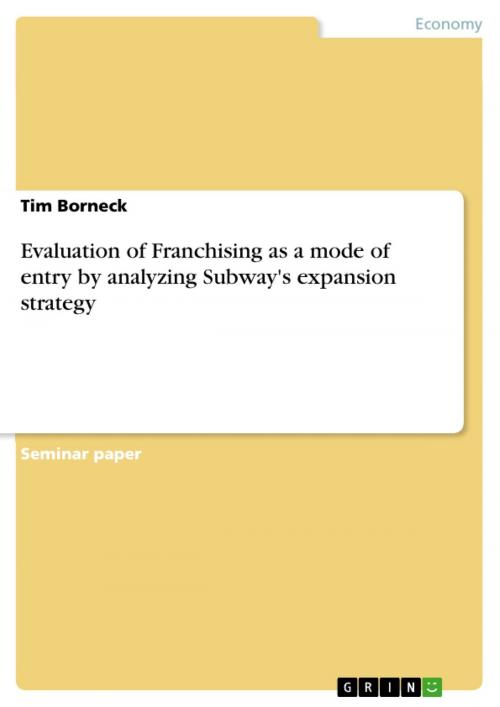Evaluation of Franchising as a mode of entry by analyzing Subway's expansion strategy
Business & Finance, Management & Leadership, Management| Author: | Tim Borneck | ISBN: | 9783668198081 |
| Publisher: | GRIN Publishing | Publication: | April 15, 2016 |
| Imprint: | GRIN Publishing | Language: | English |
| Author: | Tim Borneck |
| ISBN: | 9783668198081 |
| Publisher: | GRIN Publishing |
| Publication: | April 15, 2016 |
| Imprint: | GRIN Publishing |
| Language: | English |
Seminar paper from the year 2015 in the subject Business economics - Business Management, Corporate Governance, grade: 2,0, University of Applied Sciences Essen, language: English, abstract: Internationalization of economy is one of the most important topics of recent times. It is characterized by globalization of the business world which means that more and more companies compete with foreign ones by entering new markets or introducing new products that are available everywhere through disappearing barriers and boundaries. As a consequence the question arises how companies follow their expansion strategies. A central issue linked to this question is the entry mode decision, because it is essential for the success of the globalization activities of a company. One possible entry mode is called franchising which is used by a lot of well-known companies worldwide. The focus of this term paper is to evaluate this type of entry mode based on the example of Subway, an international operating fast food chain. To accomplish this purpose, the theory of market entry modes is explained in the beginning. Further an overview of the different entry modes is given in order to highlight the differences between them. After that franchising as a mode of entry is explained in detail. As a result of presenting the theory a profile of Subway follows. Furthermore the market entry strategy of Subway is analyzed regarding the fact how franchising influenced the expansion of the company in general. After that the market entry into the Chinese market and its challenges is explained. To conclude the term paper, the theory and the practical example is summarized in order to outline whether Subway enters new markets efficiently and how franchising as a market entry mode influences the expansion of the company against the backdrop of the example.
Seminar paper from the year 2015 in the subject Business economics - Business Management, Corporate Governance, grade: 2,0, University of Applied Sciences Essen, language: English, abstract: Internationalization of economy is one of the most important topics of recent times. It is characterized by globalization of the business world which means that more and more companies compete with foreign ones by entering new markets or introducing new products that are available everywhere through disappearing barriers and boundaries. As a consequence the question arises how companies follow their expansion strategies. A central issue linked to this question is the entry mode decision, because it is essential for the success of the globalization activities of a company. One possible entry mode is called franchising which is used by a lot of well-known companies worldwide. The focus of this term paper is to evaluate this type of entry mode based on the example of Subway, an international operating fast food chain. To accomplish this purpose, the theory of market entry modes is explained in the beginning. Further an overview of the different entry modes is given in order to highlight the differences between them. After that franchising as a mode of entry is explained in detail. As a result of presenting the theory a profile of Subway follows. Furthermore the market entry strategy of Subway is analyzed regarding the fact how franchising influenced the expansion of the company in general. After that the market entry into the Chinese market and its challenges is explained. To conclude the term paper, the theory and the practical example is summarized in order to outline whether Subway enters new markets efficiently and how franchising as a market entry mode influences the expansion of the company against the backdrop of the example.















